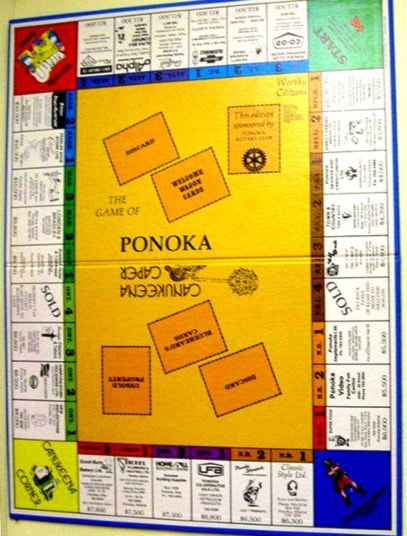Absolutely all of us, no matter what age we may be, have sometime during our lives’ become acquainted with the grand old game of Monopoly. Whether it be gathered around the kitchen table playing the world’s most popular board game with family and friends or you are now challenging today’s glitzy new versions of this red hot adventure with wealth and real-estate, it is a magnificent game that has been around our homes for countless decades.
The Game of Ponoka
In 1986, in our flourishing and growing Town of Ponoka, the local Rotary Club came up with a colourful and friendly game that followed the Monopoly concept, but with a different local fun twist. The board game would quickly become popular in the town and districts, but was also delivered free of charge by our congenial Welcome Wagon hostesses to the homes of newcomers in the community to extend greetings and to offer them coupons and prizes from participating local merchants.
The Game of Ponoka was unique in the fact that instead of featuring the usual Board Walk, Park Place, Atlantic Avenue, Railroads, utilities, and all the rest, the squares were sponsored by many of our local merchants and featured their addresses and phone numbers and a warm welcome to pop in and redeem their coupons and pick up their gifts. Ponoka-opoly was played the same way as the age-old famous game, c/w local tokens to move around the big board, values on each square, a bankroll of one million dollars for each player, and chances to pass go and collect $1000, or go directly to jail, which by the way was called ‘Blackbeard’s’ Cove.
The history of the game of Monopoly
In 1903, an American lady by the name of Lizze Magie applied for a patent on a Capitalist board game called ‘The Landlord’s Game’, which sold like hotcakes to growing families throughout North America who could have a whole lot of fun while learning about the consequences of the growing economy. Between 1906 and 1930s, a series of games were introduced which gave players from age eight to adults a unique and exciting opportunity to dabble with a big stack of play money along the avenues, railroads, bonuses, and traps of the wild wild world of buying, selling, and development. In 1933, a new company called Parker Brothers’ developed their first ‘buy and sell/win and lose’ real estate game, and then proceeded to buy out all the other franchises in 1935. The PB then began to mass-market the ‘No. 7 Black Box edition’ of Monopoly from 1936-1941, then added the Race of America version, both of which sold millions of games around the world at a price of $2 a box, and the ‘monopoly mania’ was born. Of special note in the early history of Monopoly is the fact that the Parker Brothers kindly provided thousands of their games to be shipped to our soldiers during WW2 in the prisoner of war camps in Germany. A little known fact is that not only were these game packages used for the enjoyment of the POWs, they were also carefully disguised ‘clandestine escape kits’ which had been prepared by the war department back home. These games included real money hidden below the neat stacks of play paper and cards, pawn pieces that were really compasses and files, as well as escape route maps and travel credential that were carefully hidden between the two fold-up sheets of cardboard that made up the board.
I am sure that some people in the Town and County of Ponoka still have a copy of the Game of Ponoka, but if not, you are always welcome to drop into the Fort Ostell Museum in the Lions’ Centennial Park and get up close and personal with a neat and colorful display which features games which we, now as seniors, used to play for hours on end on cold or rainy days or during real fun-times with family and friends.
